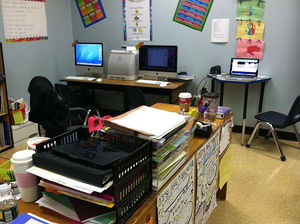Technology continues to be a hotly contested aspect of today’s educational environments, as the impact of new devices can be felt from early elementary grades to college. Some see technology as an absolute necessity for the development of future learners, while others worry that it is an expensive distraction that will never fulfill the grandiose promises that are implied in slick advertising. A recent article in the New York Times talked about how surveyed teachers are concerned that technology is changing the way that students learn. While this is a multi-sided issue, there is also the general challenge of measuring specifically how technology impacts a setting like the classroom.
Defining technology
One challenge with measuring the impact of technology is that the word itself covers a very broad category of devices and techniques. Today, the focus of educational technology includes items such as tablets, laptops, smart phones and computer-based media content. However, it wasn’t so many years ago that educators were debating the merits of standalone desktop computers, overhead projects and VCRs. New technology is touted as the future of education, and then discarded when the next hot item hits the market. The point is that these types of surveys are interesting and potentially valuable, but “technology” has been around for many years. What specifically are we talking about?
Correlation and causation
Another challenge with this topic is the issue of correlation and causation. Does technology impact the learning style of today’s students? Probably. But how? Is the student bored with the lecture because there is no accompanying animation and soundtrack? Or, is it just that the student would rather be outside running around the playground? There has obviously been a shift in how students learn, and there has been a definitive change in what students do with their free time in terms of media content. Still, there are some basics of human behavior that still apply. It may not be that the student is unable to deal with the classroom simply because they are used to playing with their tablet at home. Students have struggled to stay focused in the classroom long before the Internet was invented.
Intended uses
When you look at how technology impacts learning styles in the classroom, you have to look at the intended use of certain tools. This is particularly pertinent for certain devices. For example, a tablet can certainly be used as a powerful educational supplement if teachers know how to efficiently incorporate technology in a meaningful way. However, the reality is that tablets and other media devices are designed and marketed as entertainment devices. Students are drawn to devices because of content. If you put a tablet in the hands of a student, they will be more likely to look for Angry Birds rather than the eReader or the extra geometry modules.
Pressure to adapt
In the teaching profession, adaptation can be looked at in two ways. On the one hand, teachers should always look to adapt their style and delivery methods because the world is in constant motion. That attitude goes far beyond technology. On the other hand, there has to be a level of respect for change, and recognition that everyone loses touch with some aspects of society as they get older. Simply waving a shiny new tablet in front of a group of students will not gain instant credibility. In the same way, uttering the phrase, “when I was school” may signal that the teacher needs to seek a new profession. Ultimately, the latest technology should be studied because it has an impact on education. However, as noted by the article, “Scholars who study the role of media in society say no long-term studies have been done that adequately show how and if student attention span has changed because of the use of digital technology.” Why? The reason is that “media in society” is much like technology. Both are concepts that are a bit hard to measure.
Technology is changing the classroom. At least, that is what we think.
The author teaches at the college level and prior to entering the classroom he spent many years in higher education administration. On occasion he also enjoys the pure entertainment of substitute teaching at the high school and middle school levels.
More from this contributor:
Can the iPad Replace All Educational Technology?
Is Public Higher Education Doomed?
College Students Must Respect Credit Cards


